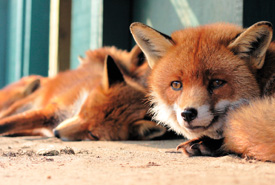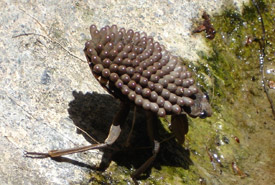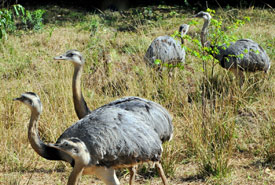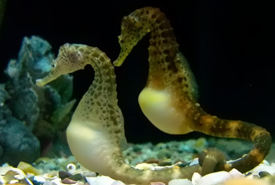Nature's most dedicated dads

Red foxes (Photo by GDallimore/Wikimedia Commons)
Across the world, millions of animal fathers strive to ensure their offspring’s survival. In honour of Father’s Day, learn about 10 of the animal kingdom’s most devoted dads and the fascinating ways they look after their brood.
Piggyback parenting

Giant water bug carrying eggs (Photo courtesy of Wikimedia Commons)
After mating, a female water bug lays up to 150 eggs on the male’s back, which remain there until they hatch a week or so later. Using his legs, the male combs through the eggs regularly to aerate them, preventing fungal infection. He also remains on the move to safeguard the eggs from predators.
Fanatic fathers
The male stickleback constantly keeps an eye on his egg clutch, fanning the eggs at 400 beats per minute to oxygenate them and get rid of waste. Once the young have hatched, he gathers any strays in his mouth for a week and puts them back in the nest.
Getting a taste of fatherhood
After they hatch, the male sea catfish will keep his young in his mouth for several months, until they reach lengths of almost five centimetres. During this time, he fasts to avoid mistakenly eating one of his offspring.
Playful papas
While mothers and recently born kits stay in their dens, red fox fathers go hunting every six hours and bring back prey for the entire family to eat. Dads have even been seen playing with their pups during their first three months of life, such as by hiding food morsels underneath twigs and leaves for the pups to find, which helps develop their foraging skills.
Fraternal frogs
After a female South American Darwin frog lays her eggs, the male swallows them and keeps them safe within his vocal sacs for about six weeks. Once they’re about to hatch, he “throws up” his young.

Rheas (Photo by Germano Roberto Shuur/Wikimedia Commons)
Single dads
The male rhea constructs a nest for his mate to lay her more than 50 eggs in. After laying her eggs, the female mates with other males. While the female is away, the male incubates the eggs for more than a month, while consuming only two weeks’ worth of food. He then looks after the young on his own for close to two years once they hatch. To maintain contact with his chicks, the male makes whistling noises. Rhea fathers even go so far as to adopt chicks that have lost their own parents.
Freezer fathers
While female emperor penguins journey to the ocean to catch fish to feed their future offspring, males incubate eggs for around 65 days in temperatures below -40 degrees Celsius. To avoid leaving the eggs unguarded, the male won’t eat anything during this time. If the chick is born before the female comes back, the father regurgitates a curd-like substance to feed it.
Polygymous papas
Wolverine fathers often travel hundreds of kilometres per month to visit their two to three mates and their kits while the females are still nursing. Male parental care likely evolved in this species because it increases the kits’ chances of survival and the probability of the male passing on his genes to the next generation.
Faithful fathers
Once their offspring are born, male marmosets are not tempted to mate with ovulating females. In fact, when scientists exposed father marmosets to sexually receptive females’ odours, the males’ testosterone levels did not change, even though they were predicted to increase as an indication of sexual arousal.

Seahorses (Photo by Joanne Merriam/Wikimedia Commons)
Prego-papas
Just like Arnold Schwarzenegger’s character in the 1994 film Junior, seahorse males get impregnated. The female transfers between 50 and 1,500 eggs into the male’s abdominal pouch, using a specialized tube called an ovipositor. The male then fertilizes the eggs within the pouch and keeps them there for between one to six-and-a-half weeks. Throughout this period, offspring are provided with nutrients, oxygen and a comfortable environment to develop. The father also maintains his offspring’s health by monitoring salt levels within his pouch to make sure they are similar to those of the external environment.


